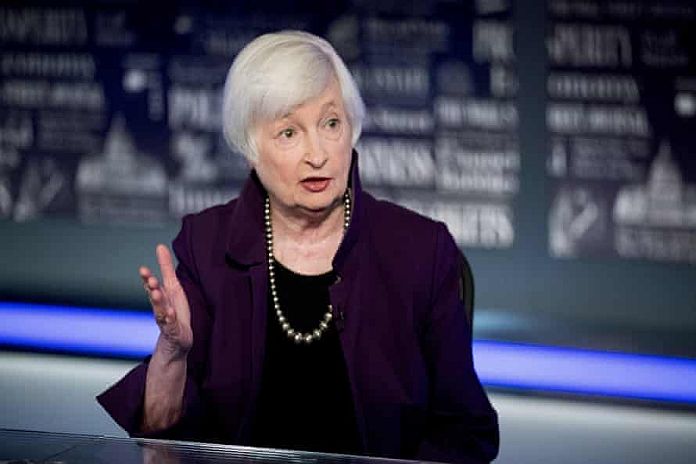Secretary of the Treasury Janet L. Yellen penned the following op-ed in The Wall Street Journal, where she reflected on developments in the American economy economic throughout 2023.
Secretary Yellen discussed improving economic conditions for American families, and investments by the Biden-Harris administration to facilitate further economic growth.
In her 2022 op-ed in The Wall Street Journal, Secretary Yellen underscored how the Biden-Harris Administration’s actions improved the economic well-being of American families and workers and strengthened the economy’s resilience in the face of global headwinds.
Secretary Yellen predicted that the US economy was, “in a uniquely strong position to capitalize on the future.” One year later, because of actions taken by the Biden-Harris administration, the US economy has seen growth in real wages and declining inflation, all while maintaining a strong labor market.
Bidenomics Is Working for the Middle Class
By Janet L. Yellen
The American economy has improved significantly over the past year, especially for the middle class. In December 2022, I shared my optimism in these pages about our country’s economic trajectory: We had gotten our economy back on its feet after weathering significant shocks and were poised for growth. It’s now clear that optimism was justified. While some forecasters predicted a 100% chance of recession this year, that didn’t happen. During the first three quarters of 2023, annualized growth averaged around 3%. Americans are applying to start businesses at a record pace, consumers are buying more, and inflation has come down substantially.
Historically, it’s rare to bring down inflation while maintaining a healthy labor market, but that’s what’s happened in the past year. The unemployment rate is near historic lows—at less than 4% for 22 months, the longest stretch in more than 50 years. Real wages have risen from their pre-pandemic levels—especially quickly for middle-income households. The typical middle-class American household has higher earnings, more wealth and more purchasing power than before the pandemic. Because wages have risen more than prices since 2019, a worker earning the median wage can today buy the same basket of goods and services as in 2019, with nearly $1,000 left over to save or spend.
Our economic position reflects actions the Biden administration has taken over the past three years. When President Biden took office, we were in the middle of a pandemic for which our country and our world was unprepared. Thousands of people were dying every week and many more were losing their livelihoods. The administration acted quickly, including through the American Rescue Plan—getting shots in arms and providing direct financial support to households and fiscal relief to local, state, tribal and territorial governments. We also helped ease supply-chain bottlenecks that had contributed to a surge in goods inflation. With healed supply chains and Americans rejoining the labor force, the American economy is producing more goods and services. This expanded supply enabled us to maintain stronger growth than many predicted, while inflation cooled.
This isn’t to say that recovery has been without its challenges. Russia’s invasion of Ukraine drove up global energy prices. In response, we took actions to hold energy prices down, releasing 180 million barrels from the Strategic Petroleum Reserve and working with a coalition of partners to put in place a novel price cap on Russian oil. Russia has seen a significant fall in oil profits, even as global energy markets remained well-supplied and energy prices declined for American families, with average gasoline prices down $1.90 a gallon from their high in June 2022.
This year, amid stresses in the banking sector, we acted to protect depositors and mitigate risks to the financial system. As a result, the U.S. avoided a panic that could have derailed our economic recovery. We’re continuing to promote financial stability, which serves as a foundation for economic growth. We’re also monitoring potential economic spill-overs from Russia’s war in Ukraine and, more recently, from the conflict in the Middle East.
We recognize that middle-class Americans continue to face costly food and rent, which matters enormously to their budgets and daily lives. President Biden and I are focused on lowering prices where we can. The Biden administration has already capped insulin costs for Americans on Medicare at $35 a month and is lowering the price of prescription drugs for seniors and the cost of health insurance for millions of working families. Our clean-energy incentives are making it cheaper for Americans to upgrade their residential energy systems and will keep energy costs lower over time.
President Biden is also taking action to support the middle class through investments that will enhance the economy’s ability to produce and create good jobs. I call this strategy modern supply-side economics. The Infrastructure Investment and Jobs Act, the Chips and Science Act, and the Inflation Reduction Act are creating incentives for private-sector investment, with companies announcing more than $600 billion of investment in clean energy and manufacturing since the start of the administration. Recent Treasury analysis shows that funding from the bipartisan infrastructure law is going where it’s most needed—to states with the lowest-rated public infrastructure and lower median household incomes—not just to the coasts and wealthy communities. Since Congress passed the Inflation Reduction Act, 70% of investments in clean energy have been in counties where the employment rate is below average, and 86% have been in counties where college-graduation rates are below average. The law has created well-paying jobs for people and places that have historically been left behind.
As we look to the new year, despite challenges and risks, there’s good reason to be optimistic about the path we’re on: rising real wages, declining inflation, and a strong labor market. Our investments and other economic policies will continue to expand the country’s productive capacity and pay dividends for middle-class Americans.





